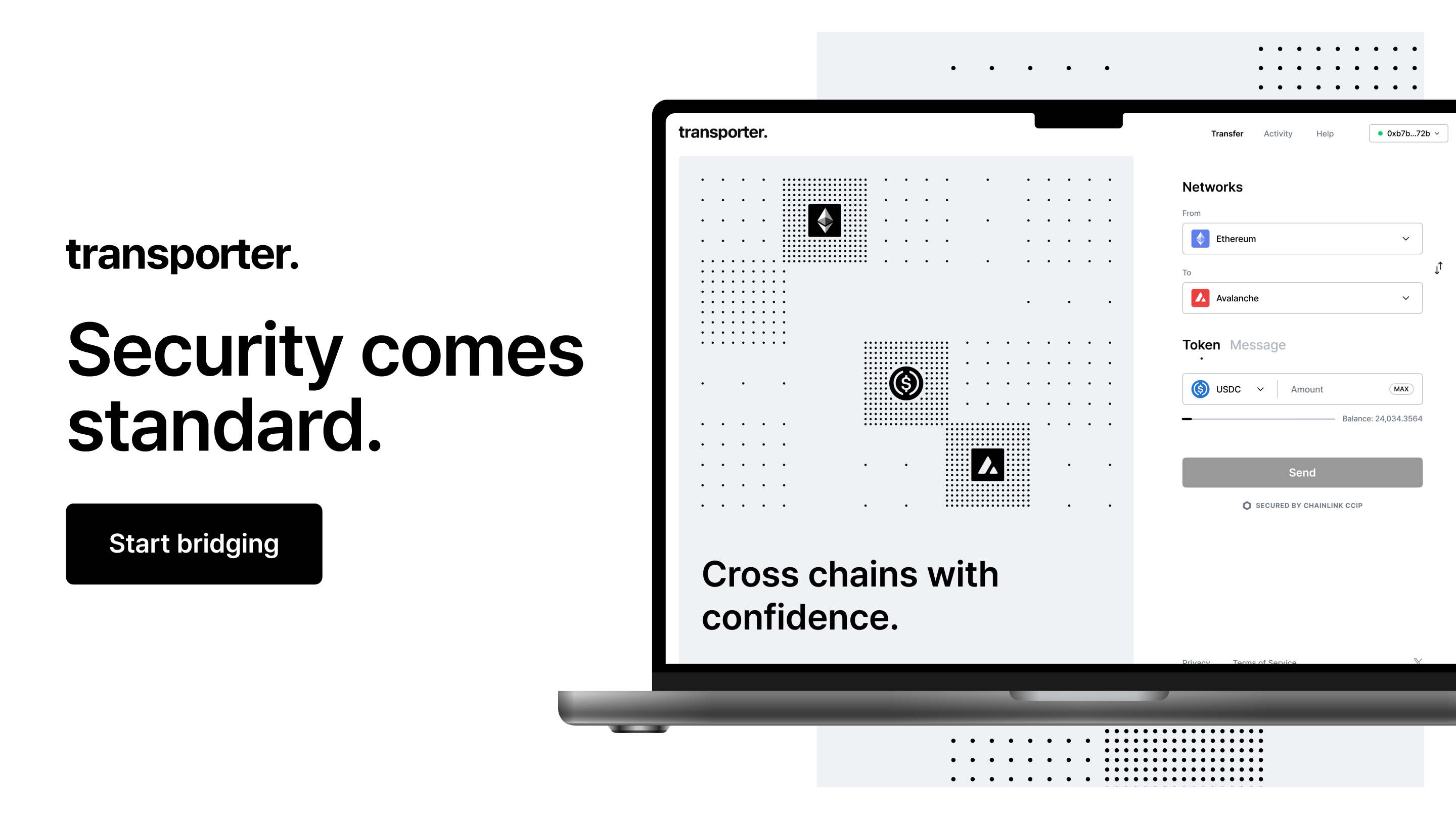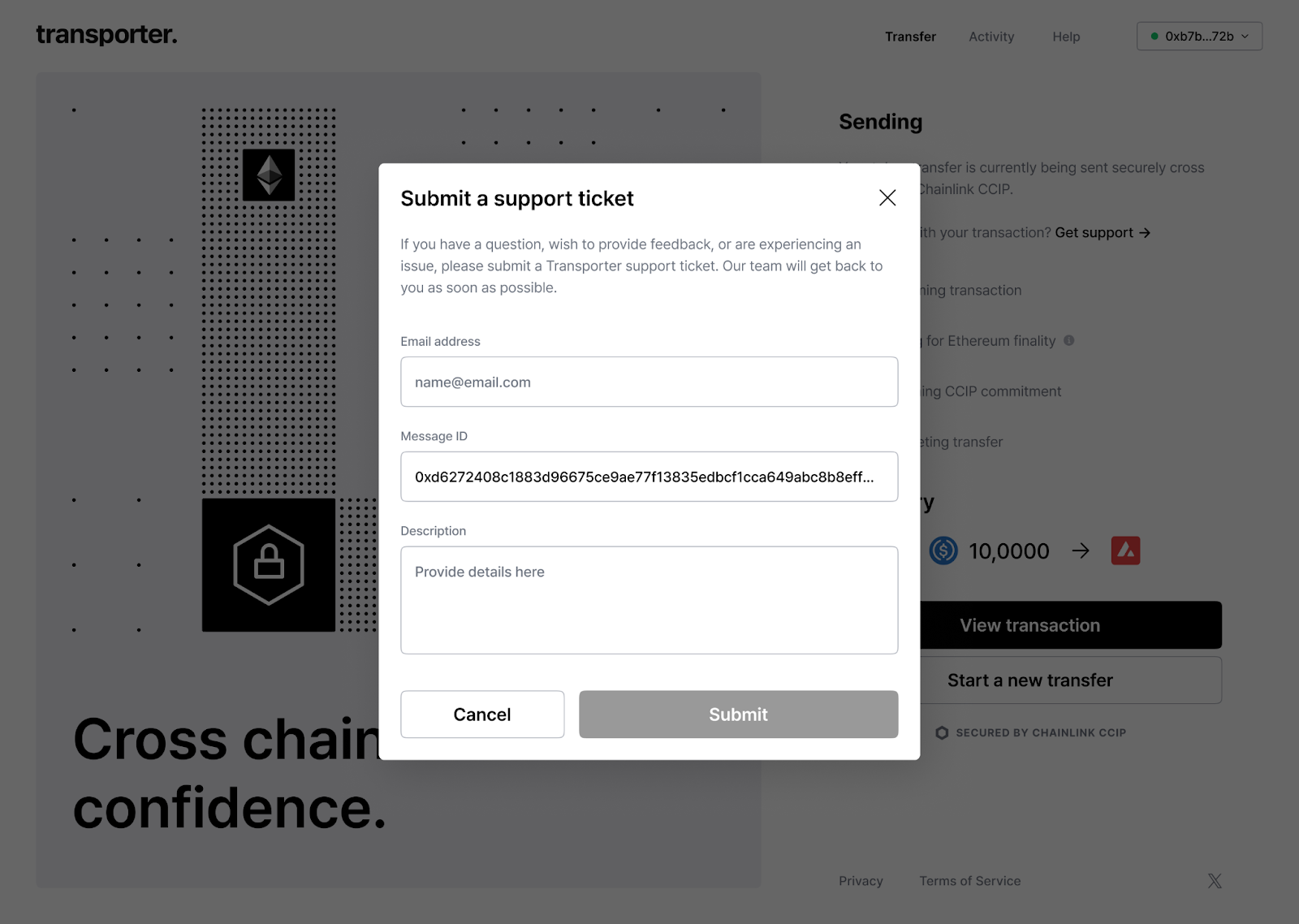Introducing Transporter: A Hyper-Secure Bridging App, Powered by Chainlink CCIP
Today, we’re excited to announce the launch of the next big CCIP-powered application. Introducing Transporter: A hyper-secure and intuitive app for bridging tokens and messages with complete peace of mind, powered by Chainlink CCIP.
Users are now able to bridge supported tokens, including ETH, USDC, LINK, and more, across eight blockchains, starting with Arbitrum, Avalanche, Base, BNB Chain, Ethereum, Optimism, Polygon, and WEMIX. Further expansion of tokens and supported chains will be ongoing.

If you are a token issuer and are interested in making your token CCIP-compatible and in doing so become eligible to be listed on Transporter, reach out here.
The Need for Secure Cross-Chain Connectivity
In an industry defined by hundreds of blockchains, layer 2s, sidechains, appchains, and more, there is a pressing need for a universal cross-chain connectivity standard. Solving this problem isn’t easy—almost 50% of all value hacked in Web3 is due to cross-chain hacks.
The multi-chain ecosystem needs cross-chain infrastructure that is hyper-reliable—a solution that raises the bar for cross-chain security and ease of use, such that any developer, project, or business, from a single entrepreneur to a global enterprise, can connect to it. An interoperability protocol that’s built to last, not just to launch.
Last year, the mainnet early access launch of Chainlink CCIP brought a host of critical features to the cross-chain developer’s toolkit to meet this need, including level-5 security and an independent Risk Management Network.
Already, some of the world’s largest institutions are realizing the value that CCIP can bring to their onchain workflows and asset management processes. On the Web3-native side, 100+ projects have or are currently integrating CCIP to securely build cross-chain smart contracts, applications, tokens, and more.
With the launch of Transporter, now everyday users can benefit from the power of CCIP.
What Is Transporter?
Transporter is an intuitive web application for crypto users to easily and securely transfer their tokens and messages between different blockchain networks. Under the hood, every Transporter transfer is powered end-to-end by Chainlink CCIP.

Built in association with the Chainlink Foundation, with support from Chainlink Labs, Transporter aims to simplify the user experience of initiating cross-chain transactions and messages with CCIP. Transporter complements the existing approach of developers integrating CCIP directly into their onchain applications.
The relationship between CCIP and interfaces like Transporter matches the approach seen throughout Web3, where different interfaces serve as different ways to interact with the same underlying protocol. CCIP is the underlying cross-chain infrastructure, while Transporter is a frontend application users interact with. Transporter is just one of many interfaces and bridging applications built on top of CCIP.

Bridge Crypto With Complete Peace of Mind
Built with a security-first mindset, Transporter offers three core benefits that provide users with complete peace of mind when bridging assets across chains.
1. Chainlink Security
All Transporter transfers are secured by Chainlink CCIP, the only cross-chain solution with level-5 security that features:
- Multiple decentralized oracle networks (DONs)—Chainlink CCIP leverages multiple independent decentralized oracle networks to further bolster its security and help ensure there are no single points of failure. The result is the only cross-chain protocol operating at level-5 security.
- Independent risk management—CCIP features an independent Risk Management Network built in a different programming language by a different team. By having a completely separate implementation for monitoring and validating the primary CCIP networks, users benefit from heightened security.
- Configurable rate limits—CCIP offers customizable per-lane and per-token rate limits, which cap the total amount of value that can be transferred cross-chain within a particular period of time. This foundational security measure significantly reduces the impact of worst-case scenarios.
- Comprehensive smart contract audits—Both the onchain and offchain code for CCIP and the Risk Management Network underwent 14 independent audits by five leading security firms before its mainnet launch, including two crowdsourced audits on Code4rena. Being subject to such a robust set of audits provides users with unmatched confidence in CCIP’s codebase.
- Battle-tested infrastructure—CCIP is powered by the same proven, defense-in-depth infrastructure and highly reliable set of node operators that have secured the Chainlink platform for 4+ years in production, collectively enabling tens of trillions in onchain transaction value.
With Transporter, users know that their cross-chain transfers are powered by a hyper-secure cross-chain protocol in Web3.
2. Real-Time Tracking
Bridging assets across blockchains can sometimes feel like throwing tokens into a black hole, with little to no visibility into what’s going on. That ends with Transporter’s real-time tracking.
Gone are the days when users stare at their screens wondering when—and often, if—their cross-chain transaction will go through successfully. Transporter’s visual transaction tracker provides users with real-time updates on the exact status of their cross-chain transfers. Information on any transaction initiated on Transporter can be viewed on the Transporter Activity tab or the Chainlink CCIP Explorer.
A transfer on Transporter follows four basic steps:
- Transaction confirmation—After a user broadcasts their transaction, it must first be confirmed and recorded on the source blockchain before it is picked up by CCIP.
- Source chain finality—A user’s transaction must then be finalized on the source chain. Finality refers to a blockchain network’s assurance that past transactions confirmed onchain are extremely difficult or impossible to revert. Waiting for source chain finality is a critical security feature of CCIP as it helps ensure tokens are locked or burned on the source chain before minting or unlocking tokens on the destination chain.
- CCIP commitment—After source chain finality has been achieved, a CCIP Committing DON will publish transaction commitments on the destination chain, which are subsequently blessed by CCIP’s independent Risk Management Network.
- Transaction execution—Once validated, the user’s transaction is processed on the destination chain by a CCIP Executing DON, at which time tokens are transferred to the user’s wallet address on the destination chain.
More information about how CCIP transactions are secured end-to-end can be found in the Chainlink documentation.

3. Superior User Experience
The hallmark of a seamless user experience in Web3 is an application’s ability to abstract away complexity. Transporter was purpose-built to provide an industry-leading user experience that abstracts away technical complexities and provides users with end-to-end support.
Here’s what you get by using Transporter:
Intuitive UI
Transporter was built with simplicity in mind so that anybody—no matter their level of Web3 expertise—can easily navigate the app. That’s why only a few simple steps are needed to send a cross-chain transaction on Transporter.

Dedicated Customer Support
Web3 users are often left to their own devices when encountering issues with a dApp. With Transporter, any user who submits a cross-chain transaction on the app and faces an obstacle can submit a support ticket to Transporter’s dedicated, 24/7 customer support team.

Quickstart Resources
For users who have simple questions on how to transfer a token or navigate the UI, Transporter offers step-by-step tutorials that can be easily followed by any user to successfully submit a cross-chain transaction.

Smart Execution
Under the hood, a cross-chain transaction requires a transaction on two blockchains—the source and destination chain. With CCIP’s Smart Execution feature, users only need to pay fees on the source blockchain, and CCIP will handle everything else on the destination chain.

Optimized and Flexible Fees
Transporter doesn’t charge additional fees, only the regular fees for using CCIP, which cover the gas costs of completing transactions on the destination chain and the fees paid to CCIP service providers. Additionally, users have flexibility in their choice of fee payment, supporting the ability to pay in LINK or in blockchain native gas tokens. Work is underway on an automated onchain conversion mechanism where fee payments made in alternative assets are auto-converted into LINK.
The Transporter Difference
Notable venture capital firms Fourth Revolution Capital and Moonrock Capital are two early users of Transporter.
“I expect that Transporter will quickly establish itself as the standard for cross-chain enablement for high-value use cases. Chainlink has proven itself time and time again, and CCIP is a powerful engine which has the potential to fuel a huge amount of growth and innovation.”
–Nomatic, Investor at Fourth Revolution Capital
“We’re excited to witness the launch of Transporter, which we expect to play a significant role in bringing secure cross-chain connectivity to a large user base across the blockchain ecosystem. We look forward to seeing Transporter’s seamless user experience and Chainlink CCIP’s unparalleled cross-chain security bring about the next stage of blockchain adoption.”
–Simon Dedic, CEO at Moonrock Capital
The Road Ahead
This is just the beginning of Transporter, and the road ahead is ripe with opportunities to support more chains, tokens, and users.
We invite all users to visit Transporter today to bridge their tokens, send messages and cross chains with confidence. To stay up-to-date on all things Transporter, make sure to follow @transporter_io on X.

Disclaimer: This post is for informational purposes only and contains statements about the future. There can be no assurance that actual results will not differ materially from those expressed in these statements, although we believe them to be based on reasonable assumptions. Interactions with blockchain networks create risks, including risks caused by user input errors. All statements are valid only as of the date first posted. These statements may not reflect future developments due to user feedback or later events and we may not update this post in response.
